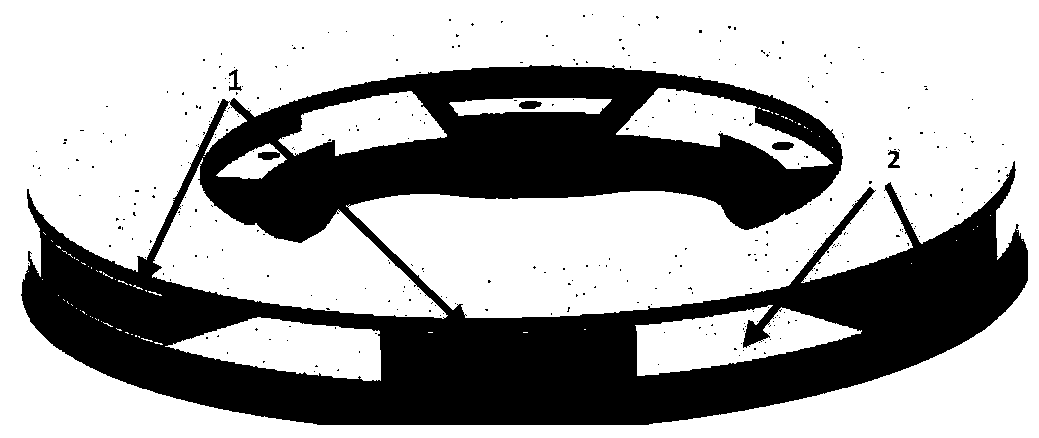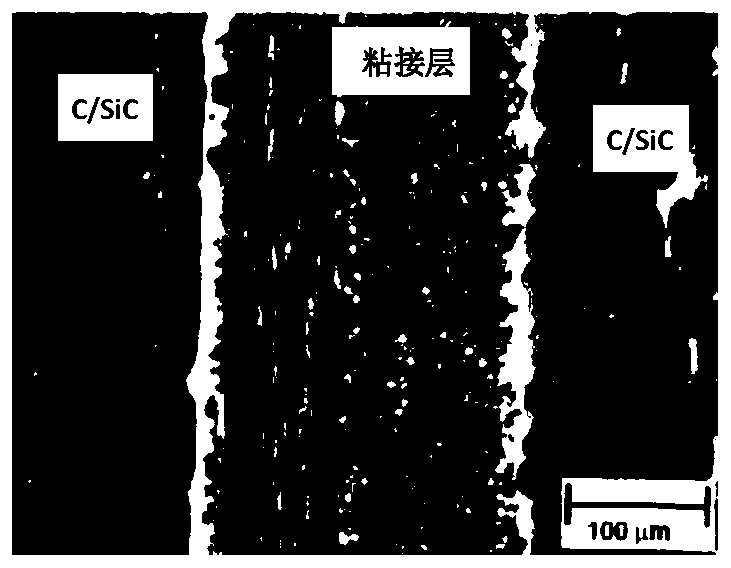Preparation method of carbon-ceramic brake disc
A technology of brake discs and carbon ceramics, applied in mechanical equipment, friction linings, etc., can solve the problems of high material hardness, increased cost of brake discs, tool loss, etc., and achieve the goal of simplifying the processing process, shortening the processing cycle, and reducing production costs Effect
- Summary
- Abstract
- Description
- Claims
- Application Information
AI Technical Summary
Problems solved by technology
Method used
Image
Examples
Embodiment 1
[0036] A method for preparing a carbon-ceramic brake disc, comprising the following steps:
[0037] (1) Preparation of carbon fiber preform
[0038] Use Toray T700-12K carbon fiber bundles to prepare unidirectional non-woven fabrics and short-fiber mesh tires, and then perform circular layup according to 0° non-woven fabrics, short-fiber mesh tires, and 90° non-woven fabrics to 1cm, then acupuncture, and then Repeat the above steps to prepare a carbon fiber preform with a size of 40cm*40cm*3cm, and ensure that the density of the carbon fiber preform is 0.45g / cm 3 , 14-16 layers / cm.
[0039] (2) Preparation of C / C composites by chemical vapor deposition
[0040] Put the carbon fiber preform into a CVI furnace for isothermal and isobaric chemical vapor deposition. The deposition temperature is 1100°C. The deposition gas is natural gas and ethylene. The natural gas flow rate is 80 SLM, the ethylene gas is 40 SLM, and the deposition time is 340 hours. The density can be obtained...
Embodiment 2
[0048] A method for preparing a carbon-ceramic brake disc, comprising the following steps:
[0049] (1) Preparation of carbon fiber preform
[0050] Use Toray T700-12K carbon fiber bundles to prepare unidirectional non-woven fabrics and short-fiber mesh tires, and then perform circular layup according to 0° non-woven fabrics, short-fiber mesh tires, and 90° non-woven fabrics to 1cm, then acupuncture, and then Repeat the above steps to prepare a carbon fiber preform with a size of 40cm*40cm*3cm, and ensure that the density of the carbon fiber preform is 0.45g / cm 3 , 14-16 layers / cm.
[0051] (2) Preparation of C / C composites by chemical vapor deposition
[0052]Put the carbon fiber prefabricated body into a CVI furnace for chemical vapor deposition. The deposition temperature is 1100°C. The deposition gas is natural gas and ethylene. The flow rate of natural gas is 80SLM, ethylene gas is 40SLM, and the deposition time is 340h. The density is 1.40g / cm 3 C / C composites.
[...
Embodiment 3
[0060] A method for preparing a carbon-ceramic brake disc, comprising the following steps:
[0061] (1) Preparation of carbon fiber preform
[0062] Use Toray T700-12K carbon fiber bundles to prepare unidirectional non-woven fabrics and short-fiber mesh tires, and then perform circular layup according to 0° non-woven fabrics, short-fiber mesh tires, and 90° non-woven fabrics to 1cm, then acupuncture, and then Repeat the above steps to prepare a carbon fiber preform with a size of 40cm*40cm*3cm, and ensure that the density of the carbon fiber preform is 0.45g / cm 3 , 14-16 layers / cm.
[0063] (2) Preparation of C / C composites by chemical vapor deposition
[0064] Put the carbon fiber preform into a CVI furnace for chemical vapor deposition. The deposition temperature is 1100°C. The deposition gas is natural gas and ethylene. The natural gas flow rate is 80SLM, the ethylene gas is 40SLM, and the deposition time is 340h. The density is 1.4g / cm 3 C / C composites.
[0065] (3) ...
PUM
| Property | Measurement | Unit |
|---|---|---|
| Density | aaaaa | aaaaa |
Abstract
Description
Claims
Application Information
 Login to View More
Login to View More - R&D
- Intellectual Property
- Life Sciences
- Materials
- Tech Scout
- Unparalleled Data Quality
- Higher Quality Content
- 60% Fewer Hallucinations
Browse by: Latest US Patents, China's latest patents, Technical Efficacy Thesaurus, Application Domain, Technology Topic, Popular Technical Reports.
© 2025 PatSnap. All rights reserved.Legal|Privacy policy|Modern Slavery Act Transparency Statement|Sitemap|About US| Contact US: help@patsnap.com



